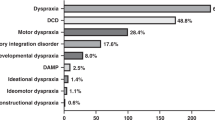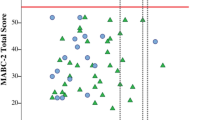Abstract
Data from 326 children taught consecutively in a physical education clinic were reviewed. Only 63 children (39 males, 24 females) (19%) met the diagnostic criteria for developmental coordination disorder (DCD) specified by the American Psychiatric Association (2000). The other children were diagnosed with neuromuscular disorders and medical conditions. After an average intervention period of 12 weeks, the mean performance percentile of children with DCD significantly improved beyond the cutoff of the diagnostic criteria. Student teachers’ knowledge of the constraint-based approach, in addition to knowledge of the more traditional information-processing approach, made no difference to the intervention outcome. Results showed that children with DCD benefited from either the constraint-based approach or the information-processing approach to individual physical education programs. This review also highlighted the need for direct services in the treatment of developmental and physical disabilities. In addition to treatment programs affiliated with universities, family focused or community based intervention may be realistic and potential solutions under the financial constraints on the educational and medical systems.

Similar content being viewed by others
References
American Psychiatric Association (1994). Diagnostic and statistical manual of mental disorders (4th ed.). Washington, DC: American Psychiatric Association.
American Psychiatric Association (2000). Diagnostic and statistical manual of mental disorders, 4th Edition, Text Revision. Washington, D. C.: American Psychiatric Association.
Anson, J. G. (2000). Movement development clinic annual report 1992: Preamble and history. In M. Miyahara (Ed.) Learning from individual movement development (pp. 42–43). Dunedin, New Zealand: Movement Development Clinic.
Arnheim, D. D., & Sinclair, W. A. (1975). They clumsy child: A program of motor therapy. Saint Louis: The C. V. Mosby Company.
Bronfenbrenner, U. (1989). Ecological systems theory. Annals of Child Development, 22, 723–742.
Cairney, J., Hay, J. A., Faught, B. E., Wade, T. J., Corna, L., & Flouris, A. (2005). Developmental coordination disorder, generalized self-efficacy toward physical activity and participation in organized and free play activities. Journal of Pediatrics, 147, 515–520.
Cairney, J., Hay, J. A., Wade, T. J., Faught, B. E., & Flouris, A. (2006). Developmental coordination disorder and aerobic fitness: Is it al in their heads or is measurement still the problem? American Journal of Human Biology, 18, 66–70.
Cassidy, T. (2000). Clinic revisited: A pedagogical perspective of movement development. In M. Miyahara (Ed.) Learning from individual movement development (pp. 34–39). Dunedin, New Zealand: Movement Development Clinic.
Cousins, M., & Smyth, M. M. (2003). Developmental coordination impairments in adulthood.. Human Movement Science, 22, 433–459.
Cummins, A., Piek, J. P., & Dyck, M. J. (2005). Motor coordination, empathy, and social behaviour in school-aged children. Developmental Medicine and Child Neurology, 47, 437–442.
DiRocco, P., & Klein, R. (2001). Dynamical systems approach to bicycle instruction. In M. Dinold, G. Gerber, & T. Reinelt (Eds.) “Towards a society for all”—Through adapted physical activity. Proceedings of the 13th International symposium adapted physical activity 2001 (pp. 462–465). Wien: Manz Verlag Schulbuch.
Endacotta, R., & Bottib, B. (2005). Clinical research 3: Sample selection. Intensive and Critical Care Nursing, 21, 51–55.
Faught, B. E., Hay, J. A., Cairney, J., & Flouris, A. (2005). Increased risk for coronary vascular disease in children with developmental coordination disorder. Journal of Adolescent Health, 37, 376–380.
Getchell, N., & Gagen, L. (2006). Adapting activities for all children: Considering constraints can make planning simple and effective. Palaestra, 22, 20–58.
Gill, R. (1993). Screening for perceptual–motor dysfunction: Reliability and validity of two instruments. Dunedin, New Zealand: A Dissertation Submitted in Partial Fulfillment of the Degree of Bachelor of Physical Education (Honors) at the University of Otago.
Hands, B., & Larkin, D. (2001). Developmental coordination disorder: A discrete disability. New Zealand Journal of Disability Studies, 9, 93–105.
Haywood, K. M. (1986). Life span motor development (1st ed.). Champaign, IL: Human Kinetics.
Haywood, K. M. (1993). Life span motor development (2nd ed.). Champaign, IL: Human Kinetics.
Haywood, K. M., & Getchell, N. (2001). Life span motor development (3rd ed.). Champaign, IL: Human Kinetics.
Henderson, S. E., Knight, E., Losse, A., & Jongmans, M. (1991). The clumsy child in school: Are we doing enough? British Journal of Physical Education, 9, 2–8.
Henderson, S. E., & Sugden, D. A. (1992). Movement assessment battery for children: Manual. London: Psychological Corporation.
Hoelter, G., Reichenbach, C., & Maassen, A. (2000). Movement day treatment centre, University of Dortmund, Germany. In M. Miyahara (Ed.) Learning from individual movement development (pp. 85–89). Dunedin, New zealand: Movement Development Clinic.
Kamps, P. (2005). The source for developmental coordination disorder (DCD). East Moline, IL: LynguiSystems.
Kuhn, T. S. (1962). The structure of scientific revolutions. Chicago: University of Chicago Press.
Larkin, D. (2000). Teaching children with motor learning difficulties: Unigym approaches. In M. Miyahara (Ed.) Learning from individual movement development (pp. 71–83). Dunedin, New Zealand: Movement Development Clinic.
Losse, A. H. S., Elliman, D., Hall, D., Knight, E., & Jongmans, M. (1991). Clumsiness in children—Do they grow out of it? A 10-year follow-up study. Developmental Medicine & Child Neurology, 33(1), 55–68.
Miyahara, M. (1996). A meta-analysis of intervention studies on children with developmental coordination disorder. Corpus, Psyche et Societas, 3(1), 11–18.
Miyahara, M. (2001). Narrative representations of moderate physical disabilities in the Specialist Education Services in New Zealand: The process and the problems of the service delivery. New Zealand Journal of Disability Studies, 9, 80–92.
Miyahara, M., & Cratty, B. J. (2004). Psychosocial functions of children and adolescents with movement disorders. In D. F. Tupper, & D. Dewey (Eds.) Developmental motor disorders. New York: Guilford.
Miyahara, M., Leeder, T., Francis, G., & Inghelbrecht, A. (2008). Does an instruction of a verbal labeling strategy for hand movements improve general motor coordination as well as the gestural performance?: A test of the relationship between developmental coordination disorder and dyspraxia. Clinical Case Studies. (in press).
Miyahara, M., & Möbs, I. (1995). Developmental dyspraxia and developmental coordination disorder. Neuropsychological Review, 5(4), 245–268.
Miyahara, M., & Piek, J. P. (2006). Self-esteem of children and adolescents with physical disabilities: Quantitative evidence from meta-analysis. Journal of Developmental and Physical Disabilities, 18, 219–234.
Miyahara, M., & Register, C. (2000). Perceptions of three terms to describe physical awkwardness in children. Research in Developmental Disabilities, 21(5), 367–376.
Miyahara, M., & Wafer, A. (2004). Clinical intervention for children with developmental coordination disorder: A multiple case study. Adapted Physical Activity Quarterly, 21(3), 281–300.
Newell, K. M. (1986). Constraints on the development of coordination. In M. G. Wade, & H. T. A. Whiting (Eds.) Motor development in children: aspects of coordination and control (pp. 341–360). Dordrecht, The Netherlands: Martinus Nijhoff.
Nolan, J. E., & Harvey, W. J. (2003). Developmental coordination disorder: Differing perspectives from Canada and the United States. New Zealand Journal of Disability Studies, 10, 117–133.
Overton, W. F., & Reese, H. W. (1973). Models of development: Methodological implications. In J. R. Nesselroade, & H. W. Reese (Eds.) Life-span developmental psychology: Methodological issues (pp. 65–86). New York: Academic.
Persons, J. B. (1991). Cognitive Therapy in Practice: A case formulation approach. New York: W.W. Norton & Company.
Pless, M., & Carlsson, M. (2000). Effects of motor skill intervention on developmental coordination disorder: A meta-analysis. Adapted Physical Activity Quarterly, 17(4), 381–401.
Polatajko, H. J., Fox, A. M., & Missiuna, C. (1995). An international consensus on children with developmental disorder. Canadian Journal of Occupational Therapy, 62(1), 3–6.
Polatajko, H. J., Kaplan, B. J., & Wilson, B. N. (1992). Sensory integration treatment for children with learning disabilities: Its status 20 years later. The Occupational Therapy Journal of Research, 12, 323–341.
Schmidt, R. A. (1988). Motor control and learning. Champaign, IL: Human Kinetics.
Sims, K., Henderson, S. E., Morton, J., & Hulme, C. (1996). The remediation of clumsiness. II: Is kinaesthesis the answer? Developmental Medicine and Child Neurology, 38, 988–997.
Smithells, P., & Smithells, O. (1974). Individual needs in physical education. Auckland, New Zealand: Heinemann Educational Books.
Sperry, L., Gudeman, J., Blackwell, B. & Faulkner, L. (1992). Psychiatric case formulation. Washington, DC: American Psychiatric Press.
Spitzer, R., Gibbon, M., Skodol, A., Williams, J., & First, M. (Eds.). (1994). DSM-IV casebook: a learning companion to the diagnostic and statistical manual of mental disorders. Washington, DC: American Psychiatric Press.
Sugden, D. A., & Chambers, M. E. (2003). Intervention in children with developmental coordination disorder: The role of parents and teachers. British Journal of Educational Psychology, 73, 545–561.
Sugden, D. A., & Henderson, S. E. (2007). Ecological intervention. London: Harcourt Brace.
Wright, M. (1997, 26 November 1997). Clumsiness not well treated. GP Weekly, p. 13.
Author information
Authors and Affiliations
Corresponding author
Rights and permissions
About this article
Cite this article
Miyahara, M., Yamaguchi, M. & Green, C. A Review of 326 Children with Developmental and Physical Disabilities, Consecutively Taught at the Movement Development Clinic: Prevalence and Intervention Outcomes of Children with DCD. J Dev Phys Disabil 20, 353–363 (2008). https://doi.org/10.1007/s10882-008-9102-z
Received:
Accepted:
Published:
Issue Date:
DOI: https://doi.org/10.1007/s10882-008-9102-z




